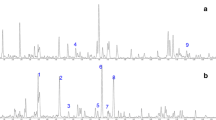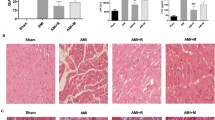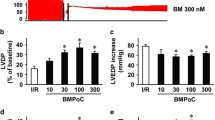Abstract
Trimetazidine (TMZ) has been demonstrated to have protective effects against myocardial ischemia/reperfusion (MI/R) injury. In the present study, we investigated the effects and the underlying mechanisms of TMZ on autophagy during MI/R in vivo and in vitro. In the in vivo study, an animal model of MI/R was induced by coronary occlusion. TMZ (20 mg/kg/day) protected the rat hearts from MI/R-induced heart failure by increasing ejection fraction and fractional shortening and decreasing end-systolic volume, end-diastolic volume, left ventricular (LV) internal diameter at systole, and LV internal diameter at diastole; it alleviated myocardial injury and oxidative stress by decreasing LDH, creatine kinase MB isoenzyme, ROS, and MDA levels and increasing SOD and glutathione peroxidase levels in plasma. TMZ also reduced myocardial infarct size and apoptosis. Moreover, TMZ markedly inhibited MI/R-induced autophagy by decreasing the protein and messenger RNA levels of LC3-II, Beclin1, ATG5, and ATG7 and the number of autophagosomes and by involving the AKT/mTOR pathway. Further, in the in vitro experiments, H9c2 cells were incubated with TMZ (40 μM) to explore the direct effects of TMZ following exposure to hypoxia and reoxygenation (H/R). TMZ increased cell viability and the concentration of intracellular SOD and inhibited H/R-induced cell apoptosis and ROS production. Moreover, TMZ decreased the number of autophagosomes and autophagy-related protein expression; it also upregulated p-AKT and p-mTOR expression. In addition, TMZ augmented Bcl-2 protein expression and diminished Bax protein expression, the Bax/Bcl-2 rate, and cleaved caspase-3 level. However, these effects on H9c2 cells were notably abolished by the PI3K inhibitor LY294002. In conclusion, our results showed that TMZ inhibited I/R-induced excessive autophagy and apoptosis, which was, at least partly, mediated by activating the AKT/mTOR pathway.
Key messages
-
TMZ improved cardiac function, alleviated myocardial injury and oxidative stress, and reduced the myocardial infarct area and apoptosis.
-
TMZ inhibited MI/R-induced myocardial autophagy, H/R-induced H9c2 cell apoptosis, and autophagy flux.
-
The effect of TMZ on autophagy was repressed by LY294002.
-
TMZ protected against MI/R injury by inhibiting excessive autophagy via activating the AKT/mTOR pathway.







Similar content being viewed by others
References
Gewirtz H, Dilsizian V (2017) Myocardial viability: survival mechanisms and molecular imaging targets in acute and chronic ischemia. Circ Res 120:1197–1212
Hausenloy DJ, Yellon DM (2015) Targeting myocardial reperfusion injury—the search continues. N Engl J Med 373:1073–1075
Seidlmayer LK, Juettner VV, Kettlewell S, Pavlov EV, Blatter LA, Dedkova EN (2015) Distinct mPTP activation mechanisms in ischaemia-reperfusion: contributions of Ca2+, ROS, pH, and inorganic polyphosphate. Cardiovasc Res 106:237–248
Bourke LT, McDonnell T, McCormick J, Pericleous C, Ripoll VM, Giles I, Rahman A, Stephanou A, Ioannou Y (2017) Antiphospholipid antibodies enhance rat neonatal cardiomyocyte apoptosis in an in vitro hypoxia/reoxygenation injury model via p38 MAPK. Cell Death Dis 8:e2549. https://doi.org/10.1038/cddis.2016.235
Sciarretta S, Maejima Y, Zablocki D, Sadoshima J (2017) The role of autophagy in the heart. Annu Rev Physiol 80:1–26
Gustafsson AB, Gottlieb RA (2009) Autophagy in ischemic heart disease. Circ Res 104:150–158
Ma X, Liu H, Foyil SR, Godar RJ, Weinheimer CJ, Diwan A (2012) Autophagy is impaired in cardiac ischemia-reperfusion injury. Autophagy 8:1394–1396
Hao M, Zhu S, Hu L, Zhu H, Wu X, Li Q (2017) Myocardial ischemic postconditioning promotes autophagy against ischemia reperfusion injury via the activation of the nNOS/AMPK/mTOR pathway. Int J Mol Sci 18. https://doi.org/10.3390/ijms18030614
Matsui Y, Takagi H, Qu X, Abdellatif M, Sakoda H, Asano T, Levine B, Sadoshima J (2007) Distinct roles of autophagy in the heart during ischemia and reperfusion: roles of AMP-activated protein kinase and Beclin 1 in mediating autophagy. Circ Res 100:914–922
Sadoshima J (2008) The role of autophagy during ischemia/reperfusion. Autophagy 4:402–403
Tannous P, Zhu H, Nemchenko A, Berry JM, Johnstone JL, Shelton JM, Miller FJ Jr, Rothermel BA, Hill JA (2008) Intracellular protein aggregation is a proximal trigger of cardiomyocyte autophagy. Circulation 117:3070–3078
Quinsay MN, Thomas RL, Lee Y, Gustafsson AB (2010) Bnip3-mediated mitochondrial autophagy is independent of the mitochondrial permeability transition pore. Autophagy 6:855–862
Kroemer G, Levine B (2008) Autophagic cell death: the story of a misnomer. Nat Rev Mol Cell Biol 9:1004–1010
Zhu H, Tannous P, Johnstone JL, Kong Y, Shelton JM, Richardson JA, Le V, Levine B, Rothermel BA, Hill JA (2007) Cardiac autophagy is a maladaptive response to hemodynamic stress. J Clin Invest 117:1782–1793
Huang Z, Wu S, Kong F, Cai X, Ye B, Shan P, Huang W (2017) MicroRNA-21 protects against cardiac hypoxia/reoxygenation injury by inhibiting excessive autophagy in H9c2 cells via the Akt/mTOR pathway. J Cell Mol Med 21:467–474
Fan G, Yu J, Asare PF, Wang L, Zhang H, Zhang B, Zhu Y, Gao X (2016) Danshensu alleviates cardiac ischaemia/reperfusion injury by inhibiting autophagy and apoptosis via activation of mTOR signalling. J Cell Mol Med 20:1908–1919
Di Napoli P, Di Giovanni P, Gaeta MA, D’Apolito G, Barsotti A (2007) Beneficial effects of trimetazidine treatment on exercise tolerance and B-type natriuretic peptide and troponin T plasma levels in patients with stable ischemic cardiomyopathy. Am Heart J 154:602.e601–602.e605
Zhang L, Lu Y, Jiang H, Zhang L, Sun A, Zou Y, Ge J (2012) Additional use of trimetazidine in patients with chronic heart failure: a meta-analysis. J Am Coll Cardiol 59:913–922
Ramezani-Aliakbari F, Badavi M, Dianat M, Mard SA, Ahangarpour A (2018) The beneficial effects of trimetazidine on reperfusion-induced arrhythmia in diabetic rats. Exp Clin Endocrinol Diabetes. https://doi.org/10.1055/s-0043-122881
Zhou X, Li C, Xu W, Chen J (2012) Trimetazidine protects against smoking-induced left ventricular remodeling via attenuating oxidative stress, apoptosis, and inflammation. PLoS One 7:e40424. https://doi.org/10.1371/journal.pone.0040424
Wu Q, Qi B, Liu Y, Cheng B, Liu L, Li Y, Wang Q (2013) Mechanisms underlying protective effects of trimetazidine on endothelial progenitor cells biological functions against H2O2-induced injury: involvement of antioxidation and Akt/eNOS signaling pathways. Eur J Pharmacol 707:87–94
Argaud L, Gomez L, Gateau-Roesch O, Couture-Lepetit E, Loufouat J, Robert D, Ovize M (2005) Trimetazidine inhibits mitochondrial permeability transition pore opening and prevents lethal ischemia-reperfusion injury. J Mol Cell Cardiol 39:893–899
Khan M, Meduru S, Mostafa M, Khan S, Hideg K, Kuppusamy P (2010) Trimetazidine, administered at the onset of reperfusion, ameliorates myocardial dysfunction and injury by activation of p38 mitogen-activated protein kinase and Akt signaling. J Pharmacol Exp Ther 333:421–429
Liu Z, Chen JM, Huang H, Kuznicki M, Zheng S, Sun W, Quan N, Wang L, Yang H, Guo HM et al (2016) The protective effect of trimetazidine on myocardial ischemia/reperfusion injury through activating AMPK and ERK signaling pathway. Metab Clin Exp 65:122–130
Ferraro E, Giammarioli AM, Caldarola S, Lista P, Feraco A, Tinari A, Salvatore AM, Malorni W, Berghella L, Rosano G (2013) The metabolic modulator trimetazidine triggers autophagy and counteracts stress-induced atrophy in skeletal muscle myotubes. FEBS J 280:5094–5108
Zaouali MA, Boncompagni E, Reiter RJ, Bejaoui M, Freitas I, Pantazi E, Folch-Puy E, Abdennebi HB, Garcia-Gil FA, Rosello-Catafau J (2013) AMPK involvement in endoplasmic reticulum stress and autophagy modulation after fatty liver graft preservation: a role for melatonin and trimetazidine cocktail. J Pineal Res 55:65–78
Pantazi E, Zaouali MA, Bejaoui M, Folch-Puy E, Ben Abdennebi H, Varela AT, Rolo AP, Palmeira CM, Rosello-Catafau J (2015) Sirtuin 1 in rat orthotopic liver transplantation: an IGL-1 preservation solution approach. World J Gastroenterol 21:1765–1774
Zhong Y, Zhong P, He S, Zhang Y, Tang L, Ling Y, Fu S, Tang Y, Yang P, Luo T et al (2017) Trimetazidine protects cardiomyocytes against hypoxia/reoxygenation injury by promoting AMP-activated protein kinase-dependent autophagic flux. J Cardiovasc Pharmacol 69:389–397
Klionsky DJ, Abdalla FC, Abeliovich H, Abraham RT, Acevedo-Arozena A, Adeli K, Agholme L, Agnello M, Agostinis P, Aguirre-Ghiso JA et al (2012) Guidelines for the use and interpretation of assays for monitoring autophagy. Autophagy 8:445–544
Di Napoli P, Taccardi AA, Barsotti A (2005) Long term cardioprotective action of trimetazidine and potential effect on the inflammatory process in patients with ischaemic dilated cardiomyopathy. Heart 91:161–165
Pantos C, Bescond-Jacquet A, Tzeis S, Paizis I, Mourouzis I, Moraitis P, Malliopoulou V, Politi ED, Karageorgiou H, Varonos D et al (2005) Trimetazidine protects isolated rat hearts against ischemia-reperfusion injury in an experimental timing-dependent manner. Basic Res Cardiol 100:154–160
Ruixing Y, Wenwu L, Al-Ghazali R (2007) Trimetazidine inhibits cardiomyocyte apoptosis in a rabbit model of ischemia-reperfusion. Trans Res 149:152–160
Dehina L, Vaillant F, Tabib A, Bui-Xuan B, Chevalier P, Dizerens N, Bui-Xuan C, Descotes J, Blanc-Guillemaud V, Lerond L et al (2013) Trimetazidine demonstrated cardioprotective effects through mitochondrial pathway in a model of acute coronary ischemia. Naunyn Schmiedeberg’s Arch Pharmacol 386:205–215
Qiao Z, Ma J, Liu H (2011) Evaluation of the antioxidant potential of Salvia miltiorrhiza ethanol extract in a rat model of ischemia-reperfusion injury. Molecules (Basel, Switzerland) 16:10002–10012
Dedkova EN, Seidlmayer LK, Blatter LA (2013) Mitochondria-mediated cardioprotection by trimetazidine in rabbit heart failure. J Mol Cell Cardiol 59:41–54
Zhang L, Ding WY, Wang ZH, Tang MX, Wang F, Li Y, Zhong M, Zhang Y, Zhang W (2016) Early administration of trimetazidine attenuates diabetic cardiomyopathy in rats by alleviating fibrosis, reducing apoptosis and enhancing autophagy. J Transl Med 14:109
Meyer G, Czompa A, Reboul C, Csepanyi E, Czegledi A, Bak I, Balla G, Balla J, Tosaki A, Lekli I (2013) The cellular autophagy markers Beclin-1 and LC3B-II are increased during reperfusion in fibrillated mouse hearts. Curr Pharm Des 19:6912–6918
Sciarretta S, Hariharan N, Monden Y, Zablocki D, Sadoshima J (2011) Is autophagy in response to ischemia and reperfusion protective or detrimental for the heart? Pediatr Cardiol 32:275–281
Yao T, Ying X, Zhao Y, Yuan A, He Q, Tong H, Ding S, Liu J, Peng X, Gao E et al (2015) Vitamin D receptor activation protects against myocardial reperfusion injury through inhibition of apoptosis and modulation of autophagy. Antioxid Redox Signal 22:633–650
Zheng Y, Gu S, Li X, Tan J, Liu S, Jiang Y, Zhang C, Gao L, Yang HT (2017) Berbamine postconditioning protects the heart from ischemia/reperfusion injury through modulation of autophagy. Cell Death Dis 8:e2577. https://doi.org/10.1038/cddis.2017.7
Karar J, Maity A (2011) PI3K/AKT/mTOR pathway in angiogenesis. Front Mol Neurosci 4:51
LoRusso PM (2016) Inhibition of the PI3K/AKT/mTOR pathway in solid tumors. J Clin Oncol 34:3803–3815
Jung CH, Ro SH, Cao J, Otto NM, Kim DH (2010) mTOR regulation of autophagy. FEBS Lett 584:1287–1295
Saxton RA, Sabatini DM (2017) mTOR signaling in growth, metabolism, and disease. Cell 168:960–976
Lekli I, Haines DD, Balla G, Tosaki A (2017) Autophagy: an adaptive physiological countermeasure to cellular senescence and ischaemia/reperfusion-associated cardiac arrhythmias. J Cell Mol Med 21:1058–1072
Jiang YQ, Chang GL, Wang Y, Zhang DY, Cao L, Liu J (2016) Geniposide prevents hypoxia/reoxygenation-induced apoptosis in H9c2 cells: improvement of mitochondrial dysfunction and activation of GLP-1R and the PI3K/AKT signaling pathway. Cell Physiol Biochem 39:407–421
Shu L, Zhang W, Huang C, Huang G, Su G (2017) Troxerutin protects against myocardial ischemia/reperfusion injury via Pi3k/Akt pathway in rats. Cell Physiol Biochem 44:1939–1948
Zhang Z, Li H, Chen S, Li Y, Cui Z, Ma J (2017) Knockdown of microRNA-122 protects H9c2 cardiomyocytes from hypoxia-induced apoptosis and promotes autophagy. Med Sci Monit 23:4284–4290
Acknowledgments
We sincerely thank Lixue Chen and Guangcheng Qin of the Central Laboratory and Qian Dong of the Department of Cardiology of the First Affiliated Hospital of Chongqing Medical University for their assistance with these experiments.
Funding
This work was supported by the National Natural Science Fund of China (Grant No. 81570212), the Cardiac Rehabilitation and Metabolic Therapy Research Fund (Grant No. ky_2016_12_20), the Science and Technology Plan Project of Chongqing Yuzhong District (Grant No. 20140111), the Chinese Medicine Science and Technology Project of Chongqing Health and Family Planning Commission (Grant No. ZY201702073), the Postgraduate Research and Innovation Project of Chongqing (Grant No. CYB15093), and the “Advanced” Research Foundation Project of Cardiovascular Health Institute of China Cardiovascular Health Alliance (Grant No. ky_2017_07_08).
Author information
Authors and Affiliations
Corresponding author
Ethics declarations
Conflict of interest
All authors declare that they have no competing interests.
Rights and permissions
About this article
Cite this article
Wu, S., Chang, G., Gao, L. et al. Trimetazidine protects against myocardial ischemia/reperfusion injury by inhibiting excessive autophagy. J Mol Med 96, 791–806 (2018). https://doi.org/10.1007/s00109-018-1664-3
Received:
Revised:
Accepted:
Published:
Issue Date:
DOI: https://doi.org/10.1007/s00109-018-1664-3




